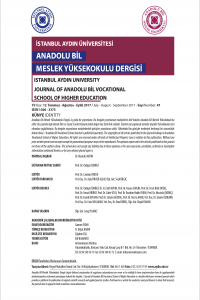Mobil iletişimde yeni mobilite gerçeği
Haberleşme araçları son yıllarda geleneksel iletişim formatını değiştirerek daha kişisel iletişim ortamlarına dönüşmeye başlamıştır. Mobil iletişimin bunda önemli bir rolü vardır. Mobil teknolojideki gelişmeler insanlara uzaklıkları iletişimle kısaltmak, zaman kısıtlamasının üstesinden gelmek için güç vermiştir. İnsanları caddede yürürken, otobüs, tren veya metroda cep telefonları ile konuşurken görmek çok olağan olmuştur. Artık mobil teknolojinin hızla gelişip yaygınlaşması ile cep telefonuna sahip olmak günümüzün yeni mobil toplumuna dahil olmanın bir koşulu sayılmaktadır
Anahtar Kelimeler:
yeni mobilite, mobil iletişim, mobil teknoloji
New mobility reality in mobile communication
Communication devices have changed their traditional formats and have become more personal communication medium in recent years. Developments in mobile technology have given people power for overcoming time boundaries, shortening the distances through communication. It has been common today to see people using mobile phones while walking on the streets or in buses, trains and public spaces. Because of rapid adoption by societies, mobile phone is considered as a requirement for social inclusion of today’s new mobile way of life
Keywords:
new mobility, mobile communication, mobile technology,
___
- Augé, M. (2000). Non-Places: Introduction to an Anthropology of Supermodernity. J. Howe (çeviri.). London: Verso.
- Bailey, D. E. ve N. B. Kurland (2002) Review of Telework Research : Findings, New Directions, and Lessons for the Study of Modern Work. Journal of Organzational Behaviour. Vol.23, 383-400.
- Baumann, Z. (2000). Liquid Modernity. Polity Press, Cambridge.
- Belloti, V. ve S. Bly (1996). Walking Away from the Desktop Computer: Distributed Collaboration and Mobility in a Product Design Team. In Proceedings of the ACM Conference on Computer Supported Cooperative Work (CSCW’96).ACM Press, Boston MA.16th-20th November 1996
- Boden, D. ve H.L. Molotch (1994). The compulsion of proximity. R. Friedland ve D. Boden (Ed). NowHere Space, Time and Modernity içinde. Berkeley, CA: University of California Press,1994, 257–86.
- Bonns, W. ve S. Kesselring (2001) Mobilität am Übergang von der Ersten zur Zweiten Moderne. U. Beck and W. Bonss (Ed), Die Modernisierung der Moderne içinde. Frankfurt am Main: Suhrkamp, 2001, 177–90.
- Castells, M. (2000). Grassrooting the space of flows. J. Wheeler, Y. Aoyama ve B. Warf . (Ed.) Cities in the telecommunications age: the fracturing of geographies içinde. New York: Routledge.
- Cresswell, T. (2006) On the Move : Mobility in the Modern Western World. Routledge Taylor and Francis Group. New York.
- Geser, H. (2004) Towards a Sosciological Theory of the Mobile Phone, University of Zürich (Release 3.0) http://socio.ch/mobile/t_geser1.htm
- Hammer A. ve Scheiner J. (2002) Lebensstile, Milieus und räumliche Mobilität Technical
- http://www.isb.rwth-aachen.de/stadtleben/Projektschritte/AP-05-02-2002.pdf
- Kellermann A. (2006) Personal Mobilities. Routledge Taylor &Francis Group, New york
- Kristoffersen, S. ve F. Ljungberg (2000). Mobility: From stationary to mobile work. K. Braa, C. Sİrensen, and B. Dahlbom (ed). Planet Internet içinde. Lund, Sweden: Studentliteratur, 41-64.
- Kaufmann,V., Canzler, W. ve Kesselring, S. (2008). Tracing Mobilities : Towards a Cosmopolitan Perspective. Ashgate Publishing Company, Burlington.
- Larsen J., J. Urry ve K. Axhausen (2006) Networks, Mobilities and Geographies. Ashgate Publishing Limited, UK
- Ling, R., ve Yttri, B. (2002). Hypercoordination via mobile phones in Norway. J.E. Katz, M.A. Aakhus (ed.). Perpetual Contact. Mobile Communication, Private Talk, Public Performance içinde. Cambridge, UK: Cambridge University Press, 139–169.
- Luff, P. ve Heath, C. (1998) Mobility in Collaboration. Proceedings of ACM 1998 Conference on Computer Supported Cooperative Work. ACM Press. Makimoto, T. ve D. Manners (1997). Digital Nomad. John Wiley and Sons, Chichester.
- Makimoto, T. ve D. Manners (1997). Digital Nomad. John Wiley and Sons, Chichester.
- Massey, D. (2005) For Space. SAGE Publigations, London
- Mol, A. ve J.Law (1994). Regions, Networks and Fluids: Anaemia and Social Topology. Social Studies of Science. Ol.24, 641-671.
- Sheller, M. ve J. Urry, J. (2004a). Mobile transformations of ‘public’ and ‘private’ life. Theory,Culture and Society 20, 107–25.
- Simmel, G. ve K. H. Wolff (1950) The Sociology of Georg Simmel, New York: Free Press
- Sorensen C. ve M. Kakihara (2002). Knowledge Discourses and Interaction Technology. Proceedings of te 35th Hawaai International Conference on System Sciences (HICSS-35). IEEE. Big Island, Hawaai. 7th-10th January 2002.
- Townsend, A.M., S. M. DeMarie ve A.R. Hendrickson (1998). Virtual Teams : Technology and the Workplace of the Future. The Academy of Manangement Executive. Vol. 12, No.3, 17- 29.
- Tuan, Y.F. (1977). Space and Place: The Perspective of Experience. Minneapolis, MN: the University of Minnesota Press.
- Urry, J. (1999). Automobility, Car Culture and Weightless Travel: A discussion paper. http://www.lancs.ac.uk/fass/sociology/papers/urry-automobility.pdf
- Urry, J. (2004). The new mobilities paradigm. mobility and the cosmopolitan perspective workshop. Munich Reflexive Modernization Research Centre.
- Virilio, P. (2006). Çeviri : Speed and Politics. Semiotext(e) foreign agent series, Los Angeles Orijinal (1977) Vitesse et Politque : Essai de dromologie, Paris: Galilee.
- ISSN: 1306-3375
- Başlangıç: 2006
- Yayıncı: İstanbul Aydın Üniversitesi
Sayıdaki Diğer Makaleler
Çağdaş ofis anlayışı ve ‘Google’ın ‘Googleplex’ örneği
Burçin Cem ARABACIOĞLU, Pınar ARABACIOĞLU
Türk yükseköğretim alanında öğretim elemanının fonksiyonu ve bölüm/program
Mobil iletişimde yeni mobilite gerçeği
Yuvarlak örme makinelerinde meydana gelen hatalar ve çözüm önerileri
Gerilla pazarlama: Kuramsal bir çerçeve
